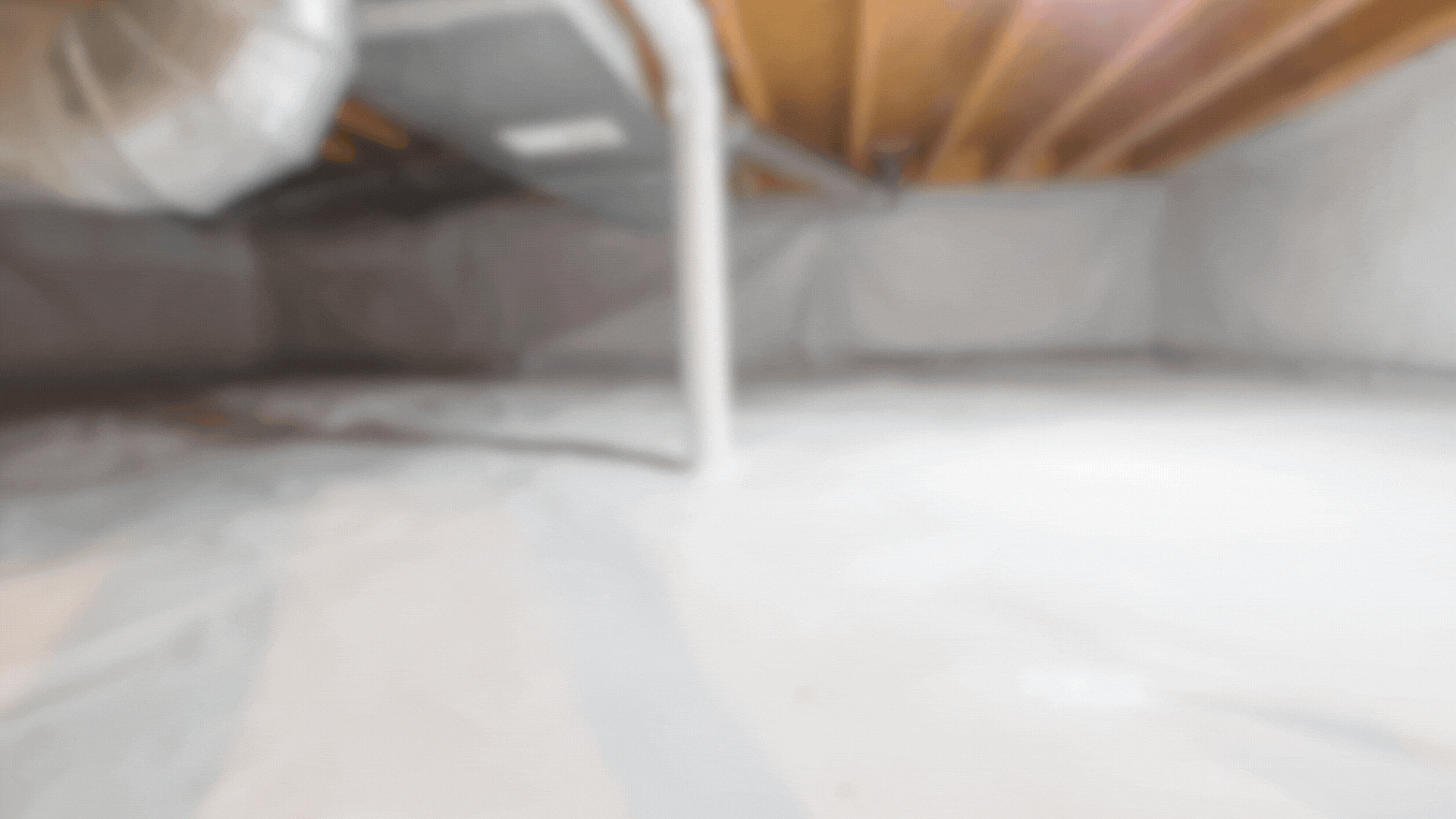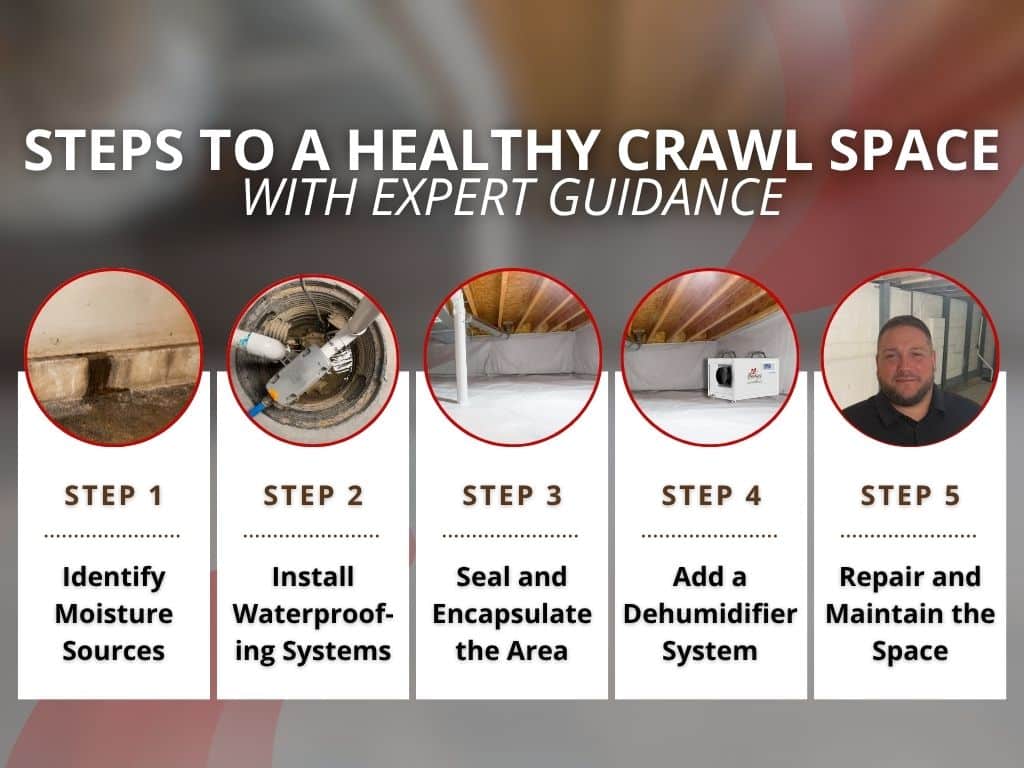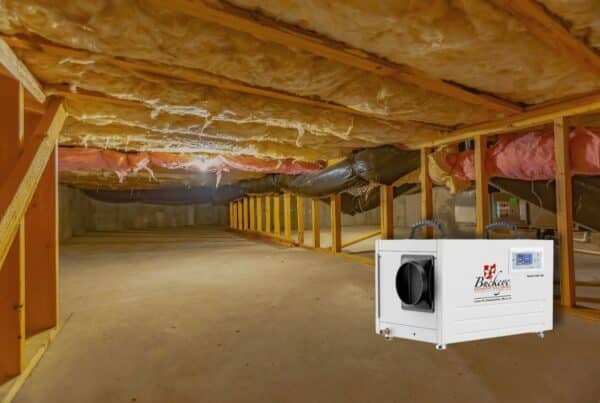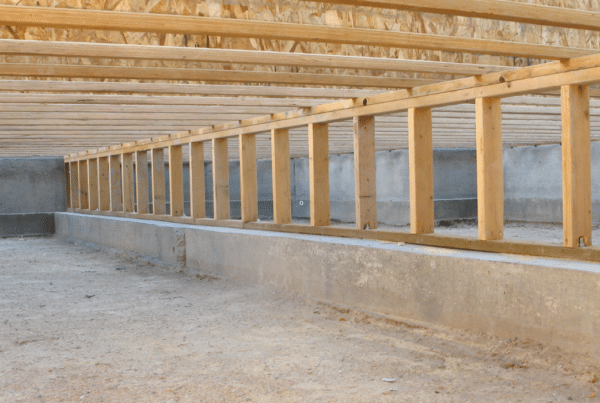Musty smells coming from your crawl space are often an early sign of excess moisture, mold growth, or poor air circulation beneath your home. For many homeowners, these odors appear during humid months or after heavy rain.
Because up to 50% of the air inside your home comes from the crawl space, that smell can easily travel through the rest of your house. Understanding why the smell happens and how to stop it is essential.
Why a Crawl Space Smells Musty
That earthy, stale odor is a direct result of moisture mixing with organic material like wood, soil, or insulation. When these elements stay damp, mold and bacteria begin to grow, releasing gases known as microbial volatile organic compounds (MVOCs).

Common causes include…
High Humidity and Condensation
Warm outdoor air can enter through crawl space vents and condense on cool surfaces, especially in summer. Over time, this moisture leads to wood rot, mold, and insulation damage.
Groundwater Seepage or Standing Water
Poor drainage, leaking gutters, or missing vapor barriers allow groundwater to pool under the house. Even shallow puddles can raise humidity levels, creating ideal conditions for mold growth.
Leaky or Unsealed Ductwork
Air leaks from HVAC ducts can introduce both moisture and dust, which feed bacteria and fungi. The Buckeye team often finds this issue during inspections in older homes with unsealed crawl space systems.
Insufficient Ventilation or Encapsulation
Traditional vented crawl spaces were once thought to prevent moisture buildup. In reality, vents allow humid outdoor air to enter and condense. Without proper encapsulation, the area becomes damp and musty year-round.
Organic Debris and Soil Contact
When the crawl space floor is exposed to dirt, natural soil gases, and moisture continually rise into the air. Combined with wood framing or stored materials, this produces that musty, “earth basement” smell
Plumbing Leaks or Overflow Lines
Even small plumbing drips or disconnected drain lines can raise moisture levels dramatically. A single leaking pipe joint can keep a crawl space damp for months, fueling mold growth and wood decay.
Why the Musty Crawl Space Smells Matter
A musty odor may not seem serious, but it signals problems that can affect your home’s structure and air quality.
- Mold Growth: The smell indicates active or recent mold activity. Spores can spread through the home’s air ducts and cause allergies or respiratory irritation. The CDC warns that prolonged exposure to mold can worsen asthma and trigger other health issues.
- Wood Rot: Consistent humidity softens wood joists and beams, weakening your foundation over time.
- Insulation Damage: Fiberglass insulation absorbs moisture easily, which reduces energy efficiency and traps odors.
- Pest Attraction: Termites, rodents, and insects thrive in damp crawl spaces, often compounding the odor problem.
- Indoor Air Impact: Through the natural “stack effect,” air from your crawl space rises into living areas. Any mold spores, dust, or odors below can easily enter bedrooms and main living spaces.
Even if the smell seems faint, it usually means conditions are developing that can worsen quickly.
How to Remove the Musty Smell
Eliminating the odor requires addressing its cause, not just masking it. Here’s how to start.
1. Dry Out the Space
The first step is lowering humidity levels. If you have standing water, a sump pump and pit system can help move water away from the foundation. Afterward, use fans or dehumidifiers rated for crawl space use.
A properly installed clean air dehumidifier system can maintain humidity below 50%, which is the level the EPA recommends to prevent mold growth. Continuous airflow and moisture control are essential for lasting results.
2. Improve Drainage Around the Home
Check that gutters and downspouts are directing water at least six feet away from your foundation. Regrading the soil so it slopes away from the house also helps reduce groundwater intrusion.
Buckeye Basement Solutions frequently installs French drains and sump systems to manage surface and subsurface water effectively. When soil or concrete slopes toward the home, even light rainfall can force moisture through foundation walls.
3. Encapsulate the Crawl Space
Encapsulation involves sealing the crawl space floor and walls with a thick vapor barrier and insulating the perimeter. This prevents humid outdoor air from entering and locks out moisture from the soil below.
Homeowners who encapsulate their crawl spaces often notice an immediate improvement in odor and indoor comfort. It also protects insulation, wiring, and wood framing from long-term damage.
In this region’s humid summers, encapsulation is often the best way to keep air quality and humidity stable year-round.
4. Repair Cracks and Seal Openings
Moisture can sneak in through even small cracks in the foundation or gaps around plumbing lines. Professional sealing prevents water entry and keeps conditioned air from escaping.
Proper sealing also improves energy efficiency since crawl spaces often share air with heating and cooling systems.
5. Remove and Replace Damaged Materials
Any wet insulation, wood, or debris should be removed and replaced. Simply drying them out is not enough once mold has taken hold. Proper cleaning and replacement ensure the smell does not return later.
When Buckeye completes a repair, the team often recommends replacing fiberglass insulation with closed-cell spray foam, which resists both moisture and pests.
Preventing the Smell from Coming Back
Once the crawl space is clean and dry, maintenance is key to keeping it that way.
| Prevention Step | Why It Matters |
| Install a dehumidifier | Keeps humidity below 50% and prevents condensation. |
| Add a vapor barrier | Stops ground moisture from entering the air. |
| Inspect gutters regularly | Prevents water from pooling near the foundation. |
| Check your sump pump | Ensures reliable drainage during storms. |
| Schedule annual inspections | Detects small leaks or damage early. |
Buckeye Basement Solutions also offers structural carpentry repair and foundation reinforcement for homes where moisture damage has weakened support beams or joists.
Taking a proactive approach to both air quality and structure gives your home a longer, healthier life.
Extra Tip: Keep crawl space doors sealed and inspect the area each season. Small signs of condensation, rust, or new odors indicate humidity is creeping back.
Acting early prevents costly damage later.
Is a Musty Crawl Space Dangerous?
Yes, potentially. The air from your crawl space rises through your home in a process called the stack effect. That means the musty air you smell below can carry mold spores, bacteria, and allergens into living areas.
Long-term exposure to these pollutants can cause symptoms such as headaches, fatigue, or coughing. In homes with young children or elderly residents, improving crawl space conditions is particularly important for respiratory health.
A musty crawl space can also signal structural problems. High humidity causes wooden beams to expand and contract, which can shift the flooring above.
Over time, this movement may lead to uneven floors or cracks in drywall that seem unrelated to moisture below.
Another hidden issue is that electrical or HVAC components that pass through the crawl space can corrode or malfunction if moisture persists.

How Professionals Fix a Musty Crawl Space
When Buckeye Basement Solutions inspects a crawl space, the focus is on finding the source of the problem. Every inspection targets where moisture starts and how air moves through the space, so the issue can be fixed for good, not just covered up.
A typical Buckeye repair process includes:
Moisture Assessment
Inspectors measure humidity and locate problem areas such as condensation, leaks, or groundwater seepage. This step identifies exactly what is causing the musty smell.
Waterproofing Solutions
If water is entering the space, Buckeye installs systems such as sump pumps, French drains, or interior drain tiles to move moisture away from the foundation.
Encapsulation and Dehumidification
A sealed vapor barrier and crawl space dehumidifier keep humidity below safe limits. This protects wood, insulation, and wiring while improving indoor air quality.
Structural Repairs
If water damage has weakened beams or joists, Buckeye’s carpentry team reinforces or replaces them using treated lumber or steel supports to restore strength and stability.
Follow-Up and Maintenance
After work is complete, Buckeye monitors humidity levels and recommends regular inspections to ensure the crawl space stays dry and odor-free.
By combining waterproofing, encapsulation, and structural repair, Buckeye Basement Solutions helps homeowners eliminate musty odors and protect their homes for the long term.
Related Maintenance & Crawl Space Questions
Why does my crawl space smell worse after rain?
Rain increases soil moisture and groundwater levels, which can seep into the crawl space through cracks or unsealed walls. Once the air becomes saturated, mold releases stronger odors.
Can I use bleach to clean mold in the crawl space?
Bleach may remove surface mold, but it cannot reach porous materials like wood. The EPA recommends using professional-grade cleaners and ensuring full moisture control to prevent regrowth.
What humidity level should my crawl space be?
Keep relative humidity below 50%. Installing a dedicated crawl space dehumidifier helps maintain that balance even in summer.
Does encapsulating the crawl space really help with odors?
Yes. Encapsulation locks out moisture and soil gases, preventing the environment that causes musty smells from forming. It also improves energy efficiency and comfort.
When to Get Help
If your crawl space smells musty despite ventilation or DIY cleaning, it is time to call a professional. Persistent odors often mean there is hidden water, mold growth, or structural damage that needs expert attention.
Buckeye Basement Solutions provides comprehensive crawl space and basement services throughout Columbus and Central Ohio. Their team specializes in:
- Crawl space encapsulation and waterproofing
- Sump pump and drainage system installation
- Dehumidifier system setup
- Structural carpentry and foundation repair
An inspection from Buckeye can identify the exact cause of the smell and provide lasting solutions that improve both indoor comfort and home value.
Pro Tip: Schedule your inspection during spring or early summer before Ohio’s humidity peaks.
Preventative moisture control saves money compared to emergency repairs after damage has already set in.
Conclusion
Musty crawl space smells are a clear sign that your home has a moisture or ventilation problem. Ignoring it allows mold, bacteria, and structural damage to worsen quietly over time.
By drying the area, improving drainage, sealing openings, and maintaining balanced humidity, you can eliminate the odor and protect your foundation for years to come.
If you are ready to stop the smell for good, contact the Buckeye Basement Solutions team for a full crawl space inspection. Their experts can design a customized plan to keep your home clean, dry, and odor-free all year long.



